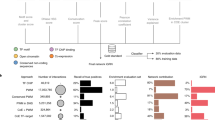Abstract
Anther development in Arabidopsis, a popular model plant for plant biology and genetics, is controlled by a complex gene network. Despite the extensive use of this genus for genetic research, little is known about its regulatory network. In this paper, the direct transcriptional regulatory relationships between genes expressed in Arabidopsis anther development were predicted with an integrated bioinformatic method that combines mining of microarray data with promoter analysis. A total of 7710 transcription factor-gene pairs were obtained. The 80 direct regulatory relationships demonstrating the highest confidence were screened from the initial 7710 pairs; three of the 80 were validated by previous experiments. The results indicate that our predicted results were reliable. The regulatory relationships revealed by this research and described in this paper may facilitate further investigation of the molecular mechanisms of anther development. The bioinformatic method used in this work can also be applied to the prediction of gene regulatory relationships in other organisms.
Similar content being viewed by others
References
Banerjee N, Zhang M Q. Functional genomics as applied to mapping transcription regulatory networks. Curr Opin Microbiol, 2002, 5(3): 313–317
Hartemink A J. Reverse engineering gene regulatory networks. Nat Biotechnol, 2005, 23(5): 554–555
Somogyi R, Sniegoski C. Modeling the complexity of genetic networks: understanding multigenetic and pleiotropic regulation. Complexity, 1996, 1: 45–63
Zou M, Conzen S D. A new dynamic Bayesian network (DBN) approach for identifying gene regulatory networks from time course microarray data. Bioinformatics, 2005, 21(1): 71–79
Tamada Y, Kim S, Bannai H, et al. Estimating gene networks from gene expression data by combining Bayesian network model with promoter element detection. Bioinformatics, 2003, 19(i2): ii227–ii236
Blais A, Dynlacht B D Constructing transcriptional regulatory networks. Genes Dev, 2005, 19: 1499–1511
Lee T I, Rinaldi N J, Robert F, et al. Transcriptional regulatory networks in Saccharomyces cerevisiae. Science, 2002, 298(5594): 799–804
Odom D T, Dowell R D, Jacobsen E S, et al. Core transcriptional regulatory circuitry in human hepatocytes. Mol Syst Biol, 2006, 2: 2006.0017, doi: 10.1038/msb4100059
Espinosa-Soto C, Padilla-Longoria P, Alvarez-Buylla E R. A gene regulatory network model for cell-fate determination during Arabidopsis thaliana flower development that is robust and recovers experimental gene expression profiles. Plant Cell, 2004, 16(11): 2923–2939
To A, Valon C, Savino G, et al. A network of local and redundant gene regulation governs Arabidopsis seed maturation. Plant Cell, 2006, 18(7): 1642–1651
Schmid M, Davison T S, Henz S R, et al. A gene expression map of Arabidopsis thaliana development. Nat Genet, 2005, 37(5): 501–506
Obayashi T, Kinoshita K, Nakai K, et al. ATTED-II: A database of co-expressed genes and cis elements for identifying co-regulated gene groups in Arabidopsis. Nucleic Acids Res, 2007, 35(Database issue): D863–D869
The Gene Ontology Consortium. Gene Ontology: Tool for the unification of biology. Nature Genet, 2000, 25: 25–29
Friso G, Ytterberg A J, Giacomelli L, et al. In-depth analysis of the thylakoid membrane proteome of Arabidopsis thaliana chloroplasts; new proteins, functions and a plastid proteome database. Plant Cell, 2004, 16: 478–499
Honys D, Twell D. Comparative analysis of the Arabidopsis pollen transcriptome. Plant Physiol, 2003, 132(2): 640–652
Wellmer F, Riechmann J L, Alves-Ferreira M, et al. Genome-wide analysis of spatial gene expression in Arabidopsis flowers. Plant Cell, 2004, 16(5): 1314–1326
Honys D, Twell D. Transcriptome analysis of haploid male gametophyte development in Arabidopsis. Genome Biol 2004, 5(11): R85
Janaki C, Joshi R R. Motif detection in Arabidopsis: Correlation with gene expression data. In Silico Biol, 2004, 4(2): 149–146
Bailey T L, Elkan C. The value of prior knowledge in discovering motifs with MEME. Proc Int Conf Intell Syst Mol Biol, 1995, 3: 21–29
Caselle M, Di Cunto F, Provero P. Correlating overrepresented upstream motifs to gene expression: A computational approach to regulatory element discovery in eukaryotes. BMC Bioinformatics 2002, 3: 7
Mahony S, Benos P V. STAMP: A web tool for exploring DNA-binding motif similarities. Nucleic Acids Res 2007, 35(Web Server issue): W253–W258
Matys V, Fricke E, Geffers R, et al. TRANSFAC: Transcriptional regulation, from patterns to profiles. Nucleic Acids Res, 2003, 31: 374–378
Matys V, Fricke E, Geffers R, et al. TRANSFAC: transcriptional regulation, from patterns to profiles. Nucleic Acids Res, 2003, 31: 374–378
Steffens N O, Galuschka C, Schindler M, et al. 2004. AthaMap: an online resource for in silico transcription factor binding sites in the Arabidopsis thaliana genome. Nucleic Acids Res, 32: D368–372
Palaniswamy S K, James S, Sun H, et al. A platform to link cis-regulatory elements and transcription factors into regulatory networks. Plant Physiol, 2006, 140(3): 818–829
Gomez-Mena C, de Folter S, Costa M M, et al. Transcriptional program controlled by the floral homeotic gene AGAMOUS during early organogenesis. Development, 2005, 132(3): 429–438
Bowman J L, Smyth D R. CRABS CLAW, a gene that regulates carpel and nectary development in Arabidopsis, encodes a novel protein with zinc finger and helix-loop-helix domains. Development, 1999, 126(11): 2387–2396
De Folter S, Immink R G, Kieffer M, et al. Comprehensive interaction map of the Arabidopsis MADS Box transcription factors. Plant Cell, 2005, 17(2): 1424–1433
Author information
Authors and Affiliations
Corresponding author
Additional information
Contributed equally to this work
Supported by the National Natural Science Foundation of China (Grant No. 30530100) and Science Foundation of Shanghai Municipal Education Commission (Grant No. 07ZZ60)
Electronic supplementary material
About this article
Cite this article
Huang, J., Yang, J., Wang, G. et al. Prediction of anther-expressed gene regulation in Arabidopsis . Chin. Sci. Bull. 53, 3198–3203 (2008). https://doi.org/10.1007/s11434-008-0381-7
Received:
Accepted:
Published:
Issue Date:
DOI: https://doi.org/10.1007/s11434-008-0381-7




